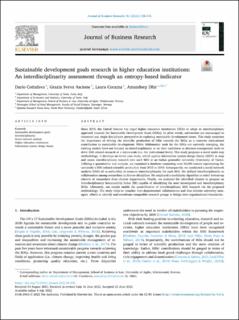| dc.contributor.author | Cottafava, Dario | |
| dc.contributor.author | Ascione, Grazia Sveva | |
| dc.contributor.author | Corazza, Laura | |
| dc.contributor.author | Dhir, Amandeep | |
| dc.date.accessioned | 2023-01-06T07:07:15Z | |
| dc.date.available | 2023-01-06T07:07:15Z | |
| dc.date.created | 2022-09-27T17:02:50Z | |
| dc.date.issued | 2022 | |
| dc.identifier.citation | Cottafava, D., Ascione, G. S., Corazza, L., & Dhir, A. (2022). Sustainable development goals research in higher education institutions: An interdisciplinarity assessment through an entropy-based indicator. Journal of Business Research, 151, 138-155. | en_US |
| dc.identifier.issn | 0148-2963 | |
| dc.identifier.uri | https://hdl.handle.net/11250/3041393 | |
| dc.description.abstract | Since 2015, the United Nations has urged higher education institutions (HEIs) to adopt an interdisciplinary approach towards the Sustainable Development Goals (SDGs). In other words, universities are encouraged to transcend any single disciplinary perspective in exploring sustainable development issues. This study examines the importance of driving the scientific production of HEIs towards the SDGs as a concrete institutional contribution to sustainable development. While bibliometric tools for the SDGs are currently emerging, the existing models have not focused on interdisciplinarity or on their usefulness as decision-management tools to drive SDG-related research at a micro-scale (i.e. the institutional level). This study proposes a novel multi-step methodology. It develops an initial case study, which applies information system design theory (ISDT) to map and assess interdisciplinary research into each SDG at an Italian generalist university (University of Turin). Utilising a quantitative text analysis, we examined a database containing over 30,000 entries representing the university’s SDG-related scientific production from 2015 to 2019. Subsequently, we conducted a social network analysis (SNA) of co-authorship to measure interdisciplinarity for each SDG. We defined interdisciplinarity as collaboration among researchers in diverse disciplines. We employed a modularity algorithm to select bottom-up clusters of researchers from diverse departments. Finally, we analysed the identified clusters to propose an Interdisciplinarity Sustainability Index (ISI) capable of identifying the most investigated and interdisciplinary SDGs. Ultimately, our results enable the quantification of interdisciplinary SDG research via the proposed methodology. The study helps to visualise inter-departmental collaborations and thus informs university managers’ efforts to identify and coordinate compatible research groups to bridge inter-organisational boundaries. | en_US |
| dc.language.iso | eng | en_US |
| dc.publisher | Elsevier | en_US |
| dc.rights | Navngivelse 4.0 Internasjonal | * |
| dc.rights.uri | http://creativecommons.org/licenses/by/4.0/deed.no | * |
| dc.title | Sustainable development goals research in higher education institutions: An interdisciplinarity assessment through an entropy-based indicator | en_US |
| dc.title.alternative | Sustainable development goals research in higher education institutions: An interdisciplinarity assessment through an entropy-based indicator | en_US |
| dc.type | Peer reviewed | en_US |
| dc.type | Journal article | en_US |
| dc.description.version | publishedVersion | en_US |
| dc.rights.holder | The author | en_US |
| dc.subject.nsi | VDP::Samfunnsvitenskap: 200 | en_US |
| dc.source.pagenumber | 138-155 | en_US |
| dc.source.volume | 151 | en_US |
| dc.source.journal | Journal of Business Research | en_US |
| dc.identifier.doi | 10.1016/j.jbusres.2022.06.050 | |
| dc.identifier.cristin | 2056071 | |
| cristin.ispublished | true | |
| cristin.fulltext | original | |
| cristin.qualitycode | 2 | |

